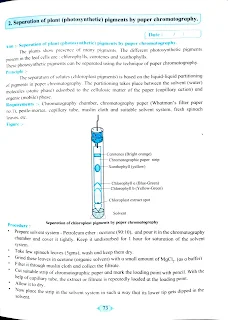Separation of plant (photosynthetic) pigments by paper chromatography
Practical Notebook Biology Standard XII
Biology
Answeres
Practical Notebook
Standard XII
Class-12th
science
2. Separation of plant (photosynthetic) pigments by paper chromatography
Aim:
Separation of plant (photosynthetic) pigments by paper chromatography. The plants show the presence of many pigments. The different photosynthetic pigments present in the leaf cells are chlorophylls, carotenes, and xanthophylls. These photosynthetic pigments can be separated using the technique of paper chromatography. Principle The separation of solutes (chloroplast pigments) is based on the liquid-liquid partitioning of pigments in paper chromatography. The partitioning takes place between the solvent (water) molecules (static phase) adsorbed to the cellulosic matter of the paper (capillary action organic (mobile) phase.)
Requirements -
Chromatography chamber, chromatography paper (Whatman's filter no.1), pestle - mortar, capillary tube, muslin cloth, suitable solvent system, fresh spinach leaves, etc. Figure: • Separation Procedure: Prepare solvent system - Petroleum ether: acetone (90:10), and pour it into the chromatography chamber and cover it tightly. it undisturbed for 1 hour for saturation of the solvent system. Take a few spinach leaves (5gms), wash them, and keep them dry. Grind these leaves in acetone (organic solvent) with a small amount of MgCl, (as a buffer) Filter it through muslin cloth and collect the filtrate. Cut a suitable strip of chromatographic paper and mark the loading point with a pencil. With the help of the capillary tube, the extractor filtrate is repeatedly loaded at the loading. point. Allow it to dry. place the strip in the solvent system in such a way that its lower tip gets dipped in the solvent. Take care not to dip it too close to the loaded spot.
Cover the chamber and keep it undisturbed to get the chromatogram run. Let the solvent travel close to the other end of the chromatography paper. Different pigments carried along with the solvent up to different heights on the basis of their molecular weights. Take out the paper, allow it to dry, and observe the separation of photosynthetic pigments in the form of separate bands of different colors. Caution: Perform the experiment in a well-ventilated laboratory.
Observation:
On the strip, we can observe the separation of photosynthetic pigments as bands of different colors in a particular sequence. From loaded spot up to the top the sequence is; chlorophyll - b (yellowish-green), chlorophyll - a (bluish-green), xanthophylls (yellow), and carotene (orange).





Comments
Post a Comment
Thank you to visit My blog